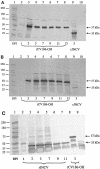Self-assembly of the recombinant capsid protein of a bovine norovirus (BoNV) into virus-like particles and evaluation of cross-reactivity of BoNV with human noroviruses
- PMID: 15695679
- PMCID: PMC548067
- DOI: 10.1128/JCM.43.2.778-785.2005
Self-assembly of the recombinant capsid protein of a bovine norovirus (BoNV) into virus-like particles and evaluation of cross-reactivity of BoNV with human noroviruses
Abstract
None of the enteric caliciviruses except Po/Sapo/GIII/Cowden/80/US replicates in cell culture, which complicates efforts to develop control strategies or to study viral replication. To develop serological assays for bovine noroviruses (BoNVs) and to determine the cross-reactivity of BoNV with human noroviruses, we generated two recombinant baculoviruses, rCV186-OH and rJNCV, to express the capsid genes of Bo/CV186-OH/00/US (Norovirus genogroup III [GIII], genotype 2 [GIII/2]). rCV186-OH expressed the expected 57-kDa capsid protein, but rJNCV expressed a truncated capsid protein of 35 kDa. Sequence analysis of rJNCV identified a single nucleotide deletion in the P domain of the capsid gene, which introduced a stop codon at amino acid 323. The recombinant capsid protein produced by rCV186-OH but not that produced by rJNCV self-assembled into virus-like particles (VLPs) similar to native BoNV. An antibody-capture enzyme-linked immunosorbent assay (ELISA) and antigen-capture ELISA (Ag-ELISA) detected serum antibody and antigen, respectively, from calves infected with Bo/CV186-OH/00/US but not antibodies or antigens to other enteric viruses. In other tests of the GIII/2 BoNV Ag-ELISA, no cross-reactivity was observed with VLPs from one GI and four GII human noroviruses and porcine sapovirus Cowden strain. Because, like human noroviruses, BoNVs do not grow in cell culture, the BoNV VLPs will be useful in the serological assays described for the detection of BoNV antibody and antigen. Consistent with the phylogenetic analysis of the capsid genes of bovine and human noroviruses (M. G. Han, J. R. Smiley, C. Thomas, and L. J. Saif, J. Clin. Microbiol. 42:5214-5224, 2004), the results suggest that GIII/2 BoNV does not share significant antigenic relationships with the five characterized human noroviruses tested.
Figures



Similar articles
-
Bovine noroviruses: A missing component of calf diarrhoea diagnosis.Vet J. 2016 Jan;207:53-62. doi: 10.1016/j.tvjl.2015.10.026. Epub 2015 Oct 23. Vet J. 2016. PMID: 26631944 Free PMC article. Review.
-
Genetic recombination between two genotypes of genogroup III bovine noroviruses (BoNVs) and capsid sequence diversity among BoNVs and Nebraska-like bovine enteric caliciviruses.J Clin Microbiol. 2004 Nov;42(11):5214-24. doi: 10.1128/JCM.42.11.5214-5224.2004. J Clin Microbiol. 2004. PMID: 15528717 Free PMC article.
-
Expression and self-assembly in baculovirus of porcine enteric calicivirus capsids into virus-like particles and their use in an enzyme-linked immunosorbent assay for antibody detection in swine.J Clin Microbiol. 2001 Apr;39(4):1487-93. doi: 10.1128/JCM.39.4.1487-1493.2001. J Clin Microbiol. 2001. PMID: 11283075 Free PMC article.
-
Cross-reactivity among sapovirus recombinant capsid proteins.Arch Virol. 2005 Jan;150(1):21-36. doi: 10.1007/s00705-004-0406-8. Epub 2004 Sep 24. Arch Virol. 2005. PMID: 15449145
-
Animal noroviruses.Vet J. 2008 Oct;178(1):32-45. doi: 10.1016/j.tvjl.2007.11.012. Epub 2008 Feb 21. Vet J. 2008. PMID: 18294883 Review.
Cited by
-
Pathogenesis of a genogroup II human norovirus in gnotobiotic pigs.J Virol. 2006 Nov;80(21):10372-81. doi: 10.1128/JVI.00809-06. J Virol. 2006. PMID: 17041218 Free PMC article.
-
Animals as Reservoir for Human Norovirus.Viruses. 2019 May 25;11(5):478. doi: 10.3390/v11050478. Viruses. 2019. PMID: 31130647 Free PMC article. Review.
-
Bovine noroviruses: A missing component of calf diarrhoea diagnosis.Vet J. 2016 Jan;207:53-62. doi: 10.1016/j.tvjl.2015.10.026. Epub 2015 Oct 23. Vet J. 2016. PMID: 26631944 Free PMC article. Review.
-
Exposure to human and bovine noroviruses in a birth cohort in southern India from 2002 to 2006.J Clin Microbiol. 2013 Jul;51(7):2391-5. doi: 10.1128/JCM.01015-13. Epub 2013 Apr 24. J Clin Microbiol. 2013. PMID: 23616452 Free PMC article.
-
Complete genomic characterization and antigenic relatedness of genogroup III, genotype 2 bovine noroviruses.Arch Virol. 2007 Feb;152(2):257-72. doi: 10.1007/s00705-006-0856-2. Epub 2006 Oct 25. Arch Virol. 2007. PMID: 17066248 Free PMC article.
References
-
- Ando, T., M. N. Mulders, D. C. Lewis, M. K. Estes, S. S. Monroe, and R. I. Glass. 1994. Comparison of the polymerase region of small round structured virus strains previously classified in three antigenic types by solid-phase immune electron microscopy. Arch. Virol. 135:217-226. - PubMed
-
- Ando, T., J. S. Noel, and R. L. Fankhauser. 2000. Genetic classification of “Norwalk-like viruses.” J. Infect. Dis. 181(Suppl. 2):S336-S348. - PubMed
-
- Berke, T., B. Golding, X. Jiang, D. W. Cubitt, M. Wolfaardt, A. W. Smith, and D. O. Matson. 1997. Phylogenetic analysis of the caliciviruses. J. Med. Virol. 52:419-424. - PubMed
Publication types
MeSH terms
Substances
Grants and funding
LinkOut - more resources
Full Text Sources
Other Literature Sources
Medical

